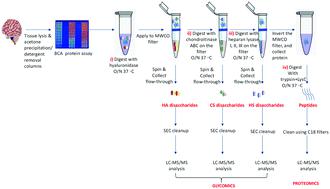当前位置:
X-MOL 学术
›
Mol. Omics
›
论文详情
Our official English website, www.x-mol.net, welcomes your feedback! (Note: you will need to create a separate account there.)
Serial in-solution digestion protocol for mass spectrometry-based glycomics and proteomics analysis.
Molecular Omics ( IF 2.9 ) Pub Date : 2020-04-06 , DOI: 10.1039/d0mo00019a Manveen K Sethi 1 , Margaret Downs , Joseph Zaia
Molecular Omics ( IF 2.9 ) Pub Date : 2020-04-06 , DOI: 10.1039/d0mo00019a Manveen K Sethi 1 , Margaret Downs , Joseph Zaia
Affiliation

|
Advancement in mass spectrometry has revolutionized the field of proteomics. However, there remains a gap in the analysis of protein post-translational modifications (PTMs), particularly for glycosylation. Glycosylation, the most common form of PTM, is involved in most biological processes; thus, analysis of glycans along with proteins is crucial to answering important biologically relevant questions. Of particular interest is the brain extracellular matrix (ECM), which has been called the “final Frontier” in neuroscience, which consists of highly glycosylated proteins. Among these, proteoglycans (PGs) contain large glycan structures called glycosaminoglycans (GAGs) that form crucial ECM components, including perineuronal nets (PNNs), shown to be altered in neuropsychiatric diseases. Thus, there is a growing need for high-throughput methods that combine GAG (glycomics) and PGs (proteomics) analysis to unravel the complete biological picture. The protocol presented here integrates glycomics and proteomics to analyze multiple classes of biomolecules. We use a filter-aided sample preparation (FASP) type serial in-solution digestion of GAG classes, including hyaluronan (HA), chondroitin sulfate (CS), and heparan sulfate (HS), followed by peptides. The GAGs and peptides are then cleaned and analyzed using liquid chromatography-tandem mass spectrometry (LC-MS/MS). This protocol is an efficient and economical way of processing tissue or cell lysates to isolate various GAG classes and peptides from the same sample. The method is more efficient (single-pot) than available parallel (multi-pot) release methods, and removal of GAGs facilitates the identification of the proteins with higher peptide-coverage than using conventional-proteomics. Overall, we demonstrate a high-throughput & efficient protocol for mass spectrometry-based glycomic and proteomic analysis (data are available via ProteomeXchange with identifier PXD017513).
中文翻译:

用于基于质谱的糖组学和蛋白质组学分析的连续溶液内消化方案。
质谱技术的进步彻底改变了蛋白质组学领域。然而,蛋白质翻译后修饰 (PTM) 的分析仍然存在差距,尤其是糖基化。糖基化是最常见的 PTM 形式,涉及大多数生物过程。因此,分析聚糖和蛋白质对于回答重要的生物学相关问题至关重要。特别令人感兴趣的是脑细胞外基质 (ECM),它在神经科学中被称为“最终前沿”,由高度糖基化的蛋白质组成。其中,蛋白聚糖 (PG) 包含称为糖胺聚糖 (GAG) 的大聚糖结构,它们形成关键的 ECM 成分,包括神经元神经网络 (PNN),在神经精神疾病中显示出改变。因此,对结合 GAG(糖组学)和 PG(蛋白质组学)分析的高通量方法的需求不断增长,以揭示完整的生物学图景。这里介绍的协议集成了糖组学和蛋白质组学来分析多类生物分子。我们使用过滤辅助样品制备 (FASP) 类型的 GAG 类串行溶液内消化,包括透明质酸 (HA)、硫酸软骨素 (CS) 和硫酸乙酰肝素 (HS),然后是肽。然后使用液相色谱-串联质谱 (LC-MS/MS) 清洁和分析 GAG 和肽。该协议是处理组织或细胞裂解物以从同一样品中分离各种 GAG 类别和肽的有效且经济的方法。该方法比可用的并行(多罐)释放方法更有效(单罐),去除 GAG 有助于鉴定具有比使用常规蛋白质组学更高的肽覆盖率的蛋白质。总体而言,我们展示了一种基于质谱的糖组学和蛋白质组学分析的高通量和高效方案(数据可用通过带有标识符 PXD017513 的 ProteomeXchange)。
更新日期:2020-04-06
中文翻译:

用于基于质谱的糖组学和蛋白质组学分析的连续溶液内消化方案。
质谱技术的进步彻底改变了蛋白质组学领域。然而,蛋白质翻译后修饰 (PTM) 的分析仍然存在差距,尤其是糖基化。糖基化是最常见的 PTM 形式,涉及大多数生物过程。因此,分析聚糖和蛋白质对于回答重要的生物学相关问题至关重要。特别令人感兴趣的是脑细胞外基质 (ECM),它在神经科学中被称为“最终前沿”,由高度糖基化的蛋白质组成。其中,蛋白聚糖 (PG) 包含称为糖胺聚糖 (GAG) 的大聚糖结构,它们形成关键的 ECM 成分,包括神经元神经网络 (PNN),在神经精神疾病中显示出改变。因此,对结合 GAG(糖组学)和 PG(蛋白质组学)分析的高通量方法的需求不断增长,以揭示完整的生物学图景。这里介绍的协议集成了糖组学和蛋白质组学来分析多类生物分子。我们使用过滤辅助样品制备 (FASP) 类型的 GAG 类串行溶液内消化,包括透明质酸 (HA)、硫酸软骨素 (CS) 和硫酸乙酰肝素 (HS),然后是肽。然后使用液相色谱-串联质谱 (LC-MS/MS) 清洁和分析 GAG 和肽。该协议是处理组织或细胞裂解物以从同一样品中分离各种 GAG 类别和肽的有效且经济的方法。该方法比可用的并行(多罐)释放方法更有效(单罐),去除 GAG 有助于鉴定具有比使用常规蛋白质组学更高的肽覆盖率的蛋白质。总体而言,我们展示了一种基于质谱的糖组学和蛋白质组学分析的高通量和高效方案(数据可用通过带有标识符 PXD017513 的 ProteomeXchange)。


























 京公网安备 11010802027423号
京公网安备 11010802027423号